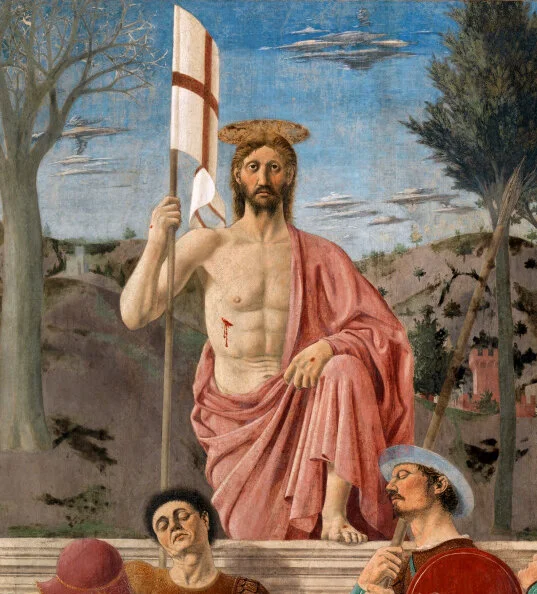Easter Series -- "Christ is risen, we are risen"
This Eastertide, we present a series of reflections on the events of Holy Week. Today's reflection is by Fr Daniel Trott, Assistant Curate at St John the Evangelist, Upper Norwood.
Acts 10.34–43; Psalm 118; 1 Corinthians 15.1–11; John 20.1–18
Easter Sunday is a day of great celebration. But why? We’re remembering a rather fantastical event that happened, or which is alleged to have happened, almost two thousand years ago. How can that still be good news? How can this man’s coming back to life still be of interest today?
+++
Let’s start back at that first Easter, and the experiences of three people.
In the first reading appointed for Easter Sunday this year, we heard St Peter, a few months after the resurrection, addressing some Gentiles (non-Jews) whom he is about to accept as Christians –- a radical move at the time. A few months before, when Jesus was on trial, this same Peter, when a servant girl noticed his conspicuous northern accent, had denied that he knew Jesus. He had said that he would never deny Jesus, but he had, and he broke down in tears when he realized what he’d done. But after the resurrection he had an encounter with the risen Jesus, who forgave him and confirmed the leading role that Peter was going to take in the early Christian movement. The risen Christ moved Peter from the death of guilt to the new life of being forgiven.
In the second Easter Sunday reading, from 1 Corinthians, we hear part of a letter Paul wrote to a church he founded in Corinth, a thriving Greek city of the Roman Empire. Paul hadn’t just denied Jesus – he’d been a zealous persecutor of Christians, considering them to be a blasphemous sect. He’d lived a life of threats and violence, completely opposed to the Christian gospel. But then the risen Jesus appeared to him, the power of the vision knocking him off his horse. Christ convinced Paul of his mistake, and commissioned him to go and preach the gospel to the Gentiles. The risen Christ moved Paul from the death of hatred to the new life of love.
And then in the gospel reading from St John's Gospel, we see Mary Magdalene, a faithful follower of Jesus, the recipient of a healing exorcism at his hands, going to Jesus’s tomb to find his body missing. After telling Peter and the Beloved Disciple, she comes back and hangs around, lost and sad. The person she’d followed for months or years is dead, and there’s not even a body to help her focus her grief. But then Jesus appears, and when she realizes who it is she’s full of joy. He gives her a message for the other disciples, and so she rushes off, the ‘apostle to the apostles’. The risen Jesus has moved her from the death of despair to the new life of hope.
We have three people here whose encounters with the risen Jesus turned their lives around. There’s Peter, brought from guilt to forgiveness; there’s Paul, brought from hatred to love; and there’s Mary Magdalene, brought from despair to hope. For them, the good news that Jesus is risen isn’t just about what’s happened to one man – his resurrection has had an effect on them. They are changed through their encounter with the risen Jesus: Jesus’s resurrection becomes their resurrection, his new life becomes their new life.
But what about us? There are things in us which are deadly: perhaps guilt, hatred, or despair, like Peter, Paul, and Mary Magdalene, or perhaps something else. Two thousand years later, how can we meet the risen Jesus? How can he bring us from death to new life?
In many churches, especially during Eastertide, we are sprinkled with water at the beginning of Mass. This is because we meet the risen Christ in our baptism. When we were symbolically drowned in water, Christ claimed us for his own, we were identified with him, and Christ’s story became our story. In baptism we died to our old selves – to guilt, hatred, and despair – and we rose to our new selves – to forgiveness, love, and hope. That connection between baptism and resurrection is why water is used at the beginning of Mass, and why it’s particularly appropriate to use it during the fifty days of Easter: to remind ourselves that through our baptism Jesus’s resurrection is our resurrection.
And although we focus on our baptism at Easter particularly, we should remember and be confident in our baptismal identity each time we come to celebrate the eucharist. At the eucharist we take the bread and wine that Jesus himself chose to be the symbols of his death, and as his priestly people we offer them to God, together with all that we are – all our guilt, all our hatred, all our despair – and we pray that as God raised Jesus’s broken body, so he may raise us up again from the death that we fall into so often. We celebrate this thanksgiving meal because we are baptized, because we have accepted Christ’s invitation to share in his new life.
So Jesus’s life, which is really God’s life, overflowed the boundaries of his thirty-or-so years on earth. It overflowed for Peter, Paul, and Mary Magdalene, and it overflows for us when we allow the risen Christ to meet us in our baptism and in the sharing of his body and blood. The resurrection of Jesus doesn’t just mean new life for him – it means new life for those who follow him. The resurrection is Jesus’s story, but it’s good news because it’s our story too. This Easter, will you embrace that new life with open arms?




